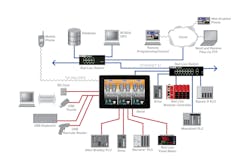Protocol Conversion and the Internet of Things
Though the Internet of Things (IoT) may be a hot topic in the media, there seems to be a bit of mystery for some around what is needed to truly make it work. The same holds true for the Industrial Internet of Things (IIoT), called Industry 4.0 by some, which may be more of a near-term reality than the broader IoT. Considering the industrial reality associated with these terms, what are some of the building blocks of IIoT?
One important building block—and a term to get familiar with now—is protocol conversion.
Wikipedia describes a protocol converter as “a device used to convert a standard or proprietary protocol of one device to the protocol suitable for the other device or tools to achieve the interoperability.” Protocol conversion is the communication fabric that enables you to collect data from different devices and different protocols and translate those in a centralized device so that you can collect and compile data from all over a facility.
Then you can turn this data into usable, trend-related information and reports that help you to make informed decisions and effectively plan your resources. Some refer to this as the mining and displaying of data for actionable intelligence, which gives you real-time visibility to help make operations more efficient.
In any industrial environment, there are often many different devices in use, with each having its own protocol. This means that organizations typically need to handle several different protocols to gather data. The ability to provide protocol conversion in a human machine interface (HMI), like Red Lion’s Graphite HMIs, or any other automation product, is a great way to connect several different devices with different protocols, and aggregate overall data collection.
Protocol conversion is important because organizations often have a mixed bag of devices that have different ages and come from different suppliers or manufacturers. Sometimes these devices can be five, 10 or even 20+ years old. So how can you be IIoT-ready when you use such legacy devices to operate many of your processes? Replacing equipment is often not an option because of cost and integration time. You need to find a way to protect your existing investment and make it compatible with more modern equipment.
Protocol conversion is a way to get there by getting devices to speak the same language, so to speak.
For example, some of the newer equipment in a facility might be Ethernet-ready, while older equipment might use a serial connection and a legacy protocol specific to that vendor. By using automation products such as Red Lion HMIs or Data Station Plus, which offer several serial, USB and Ethernet ports in combination with support for more than 300 industrial protocols, you can easily integrate different devices (and get legacy devices talking with newer devices) to get different equipment to communicate across multi-vendor environments.
Protocol conversion is a concept that you should start looking at now as part of the blueprint for your IIoT readiness plan. With protocol conversion, you can get all of your devices—old and new—communicating to provide a holistic environment view that allows you to plan more effectively and take action.
Red Lion Controls is a U.S. manufacturer of industrial automation and networking solutions that help organizations connect, monitor and control assets worldwide. Visit www.redlion.net to learn more.

